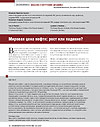World Oil Price: Growth or Decline?
The world price of oil is one of the macroeconomic indicators that significantly affect economic parameters of development in various sectors of the economy. Recently, under the influence of the current insignificant increase of this price, the expectations of its inevitable global growth have increased in the society. So, the state regulator has already prepared a number of strategic materials, including the Energy Strategy of Russia until 2035, where the price of oil in the long run returns to the level of 120–140 dollars per barrel. The authors of the article believe that such expectations of the price are not sufficiently substantiated. Moreover, basing projections on high oil prices, the state regulator may give distorted “signals” to Russian business. In this regard, the article gives a consistent argumentation, supported by the authors’ calculations, where they substantiate that the oil price is likely to “fall” into the corridor of a long-term systemic decline. So, in 2035 the price can be estimated at a value of about 35–43 dollars per barrel. The authors of the article, building the evidence base of the oil price declining trend, applying analytical and statistical methods of research, cite the results of calculations for three different variants. The article points out that the regular change in the price vector — from constantly growing to a systemically falling one — should not only form new “signals” for business and state regulator, but should also determine other boundaries for implementation of previously announced programs and forecasts.



